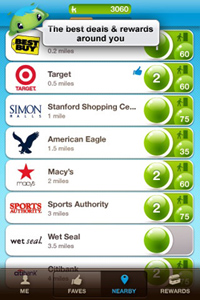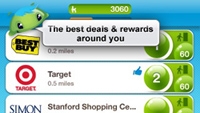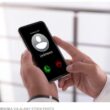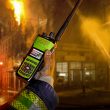Reel them in
The use of location-based services (LBS) in mobile marketing has exploded. For a retailer, knowing when its best customers are nearby — and simultaneously being able to reach out and invite them into its stores with a message or promotional offer — might seem like the ultimate marketing dream come true.
And, when done right, it can be.
LBS technologies, in their simplest form, provide the ability to track someone’s exact location through his mobile device. There are several variations on the technology and the process, but in general, LBS allows retailers to “find” customers when they come near the stores and deliver a targeted sales message, usually in the form of a text message that most phones today, from a basic feature phone to the most advanced smartphone, can send and receive.
In general, customers engage retail LBS via a mobile application (app). Customers download the app and then access all of the data and benefits through the app’s interface. Early entrants into the retail LBS game, such as the social-networking site Foursquare, required customers to do all of the work — they needed to remember to open the app and proactively “check in” at one of the establishments listed in the system. Foursquare created a rewards program to recognize their most avid users; if you’ve heard anyone declare himself the “mayor” of a bar or restaurant, that’s what they’re talking about.
From a retailer perspective, the challenge with these early entrants was two-fold. First, because the burden of checking-in was on the customer, retailers were forced to sit back and wait for customers to alert them of their presence; only then could a retailer communicate with that customer. Moreover, the system was designed primarily to appeal to consumers, rather than to the retailers that want to reach them. Benefits largely are derived through finding one’s friends and discovering new establishments. The result is a breadth, rather than a depth, of experience. So for the retailer looking to build a deeper relationship with its best customers, FourSquare can miss the mark.

The second wave of LBS apps sought to address this shortcoming by making the check-in process automatic. When Shopkick launched its app, it immediately was embraced by the retail community for the simple reason that, as long as a customer had this app open, a retailer now could identify customers and deliver messages as they walked into the store. In this way, retailers could create their own reward programs and deliver them proactively to their best customers. They could even create additional rewards and incentives by having customers scan barcodes or engage the brand in other ways via the app once they were in the store.
The downside of Shopkick and its brethren is that such apps still required the customer, on some level, to initiate the engagement. Unless customers are willing to walk around with the Shopkick app open at all times, the retailer won’t be able to deliver a timely, targeted message to them.
Of course, the fundamental shortcoming off all app-based LBS solutions is that they require a smartphone capable of downloading and opening such apps. Remember that, according to the global market research firm The Nielsen Co., despite all the press that smartphones get, two-thirds of mobile phones in use today allow calls and text messages — but not much else.
As a result, a next wave of LBS technology, called LBS 2.0, is emerging. The goal of these solutions is to address all of the nagging issues of LBS: the prerequisite that the customer acts first, the reliance on smartphone hardware in order to function and the limited ability to really understand who is coming in to the store and what they’re doing.
For instance, an LBS 2.0 solution that integrates SMS and MMS geo-fencing and geo-location would enable a retailer to deliver a completely customized and targeted message to any customer who travels within a specified distance of the store or the location of a relevant event. This happens without any action on the customer’s part, other than opting in to the program at the outset. There is no app to download and open, no Internet connectivity or GPS required for the phone, and no geographic limitations. Now, retailers can deliver targeted LBS messaging to any phone, on any carrier, at any time.
Regardless of the direction a retailer chooses when starting an LBS campaign, the following best practices will help to clear the path to success.
Get permission. LBS messaging is governed by the same rules that apply to any SMS program. Any recipient must have clearly and specifically opted in to receive the messages and there must be a way for them to opt out on every outbound message. Using a “double opt-in” procedure is recommended, as it is above any legal reproach. But consult your mobile partner to make sure that you are covered.
Reward desired behaviors. There are a wide variety of emotional drivers for customers exhibiting LBS/check-in behavior, including (but certainly not limited to) receiving discounts, being welcomed as a valued customer, connecting with friends in the store, sharing their experience and discovering new things. Think about your own marketing goals and design a program that drives the behaviors you want to see.
Make it worth their while. Once you know what you want out of your program, take a close look at your offers and make sure that they reinforce your goals and will be seen by your customers as having real value. If you’re trying to bring someone into the store, it is essential to create a sense of urgency and immediacy in your offer.
Remember that this is a conversation. Your best customers have agreed to let you say “hi” whenever they walk past. That’s a pretty amazing thing. Respect it — but also take advantage of it. Ask questions, share shopping tips, find ways to engage them even after they’ve left the area. The beautiful thing about SMS is that, once you’ve started the conversation, you can continue it regardless of where your customer goes. So make sure that your experience satisfies them. And if it didn’t, make sure that you fix it — and be sure to let them know that you did so.
Leverage social networks. Because this is a conversation, your LBS efforts need to integrate quickly and effortlessly with your Facebook, Twitter and other social -media programs. Let your customers speak for you: Follow an in-store visit with a Facebook thank-you. Allow them to share their experience in your store on your Twitter feed. One visit can easily generate up to a half-dozen subsequent messages and interactions.
Start gently. Even if someone asks for your messages, understand that the first time he walks by your store and receives a message from you may freak him out a little. So remind them that they requested this and, more importantly, make them feel welcome. Also make sure that you reward them for their loyalty. No one minds the presence of Big Brother if he’s truly here to help.
In the crowded marketing communications environment, brand-loyal customers are looking for companies to cut through the clutter and communicate in a targeted manner. Studies have shown repeatedly that LBS programs are one of the most effective ways to do this. Start small, build a loyal and appreciative base, and soon you’ll see increased floor traffic, higher sales and an ROI for the program that will outshine virtually everything else you are doing.
Jesse Crowe is CEO of VMBC, an Irvine, Calif.–based voice and mobile business-solutions provider.
Related Stories













